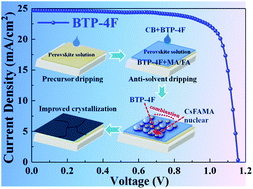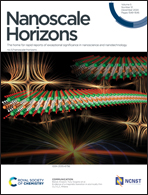Interface and grain boundary passivation for efficient and stable perovskite solar cells: the effect of terminal groups in hydrophobic fused benzothiadiazole-based organic semiconductors†
Abstract
The defects at the interface and grain boundaries (GBs) of perovskite films limit the performance of perovskite solar cells (PSCs) seriously. Herein, organic semiconductors with different terminal groups including a ladder-type electron-deficient-core-based fused structure (DAD) fused core with 2-(3-oxo-2,3-dihydro-1H-inden-1 ylidene)malononitrile (BTP-4H), DAD with 2-(5,6-dichloro-3-oxo-2,3-dihydro-1H-inden-1 ylidene)malononitrile (BTP-4Cl), and DAD with 2-(5,6-difluoro-3-oxo-2,3-dihydro-1H-inden-1 ylidene)malononitrile (BTP-4F) are introduced into perovskite films to study the effects of the terminal groups on the PSC performance. A physical model is proposed to understand the effects of the terminal groups on the perovskite growth and energy level alignment of devices. Compared with BTP-4H and BTP-4Cl, BTP-4F can more effectively delay the crystallization rate and increase the crystal sizes due to hydrogen bonding of F and FA. BTP-4F can also provide more efficient charge transport channels due to the optimal energy level alignment. Most importantly, BTP-4F can promote charge transport from the perovskite film to spiro-OMeTAD and to SnO2, thus realizing simultaneous up-bottom passivation of perovskite films. Finally, the BTP-4F passivated PSCs exhibit a remarkable PCE of 22.16%, and the device can maintain ∼86% of the initial PCE after 5000 h. Therefore, this work presents significant potential of organic semiconductors in PSCs toward high efficiency and high stability due to the terminal groups.



 Please wait while we load your content...
Please wait while we load your content...